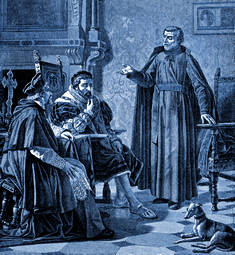Lives of the Saints
Our Models and Protectors
Spiritual Bouquet:
April 27

Saint Peter Canisius
Doctor of the Church
(1521-1597)
Born in 1521 of a distinguished family of Holland, Saint Peter Canisius studied in Cologne and received his license as doctor of civil law; he then went to Louvain (Belgium) to learn canon law. These studies followed close upon the days when Luther had burnt the papal bulls at Wittenberg, Germany. Soon Saint Peter, become a Jesuit, was teaching at the University of Cologne; he was there when the unfortunate archbishop of that city fell into the new heresy. The Catholics who desired to depose him needed a deputy to the emperor to present their request, and Saint Peter was chosen.
His mission, seconded by the Holy Spirit, succeeded; and the deputy was remarked by a Cardinal, who desired to send him to the Council of Trent as his representative and theologian. Saint Peter's superior, Saint Ignatius of Loyola himself, approved this choice, and the young Jesuit took his place among the Fathers of the Council. He was commissioned to draft a memoir on the exact nature of the errors being propagated in the lands of the reform, in consort with the Pope's theologian, another Jesuit named Jacques Laynez. Their work was admired; the Council was dissolved soon afterwards, however, and Saint Peter was recalled to Rome by Saint Ignatius, to consult with him concerning the formation of the religious and the future of their Order.
Afterwards Saint Peter and two other Jesuits founded a college at Ingolstadt, going there with only two books in their baggage, the Spiritual Exercises of Saint Ignatius and the famous Ratio Studiorum, or Plan of Studies of their Order. Saint Peter was named Rector of the University by that institution.
He was in demand everywhere; King Ferdinand of Rome obtained his presence for Vienna. A pestilence broke out there, and he was most often found at the bedside of the dying, caring for the bodies and regenerating the souls of the unfortunate citizens. He opened a boarding school for boys, and Vienna soon found itself reborn in the faith: the famous Catechism of Saint Peter Canisius had much to do with the renovation. During his lifetime it appeared in more than 200 editions, in at least twelve languages. It remains a monument of the triumph of the Church over error in the time of Luther.
Its author had tried to keep his name a secret but did not succeed, and then several nations disputed the honor of his presence. But Saint Peter was Provincial of Germany, named by Saint Ignatius, and he concerned himself above all with the colleges at Prague, Ingolstadt and Munich. Until his death in 1597 the Apostle of Germany continued the valiant and perpetual combat of the Church against error. For a long time forgotten, Saint Peter was canonized and declared a Doctor of the Church by Pope Pius XI in 1927.
Les Petits Bollandistes: Vies des Saints, by Msgr. Paul Guérin (Bloud et Barral: Paris, 1882), Vol. 14; The Catholic Encyclopedia, edited by C. G. Herbermann with numerous collaborators (Appleton Company: New York, 1908).